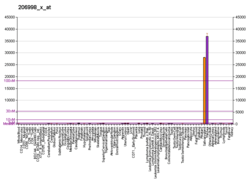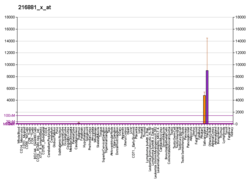PRB3
Basic salivary proline-rich protein 3 is a protein that in humans is encoded by the PRB3 gene.[3][4]
| PRB3 | |||||||||||||||||||||||||
|---|---|---|---|---|---|---|---|---|---|---|---|---|---|---|---|---|---|---|---|---|---|---|---|---|---|
| Identifiers | |||||||||||||||||||||||||
| Aliases | PRB3, G1, PRG, proline-rich protein BstNI subfamily 3, proline rich protein BstNI subfamily 3 | ||||||||||||||||||||||||
| External IDs | OMIM: 168840 HomoloGene: 133260 GeneCards: PRB3 | ||||||||||||||||||||||||
| |||||||||||||||||||||||||
| |||||||||||||||||||||||||
| Orthologs | |||||||||||||||||||||||||
| Species | Human | Mouse | |||||||||||||||||||||||
| Entrez |
| ||||||||||||||||||||||||
| Ensembl |
| ||||||||||||||||||||||||
| UniProt |
| ||||||||||||||||||||||||
| RefSeq (mRNA) |
| ||||||||||||||||||||||||
| RefSeq (protein) |
|
| |||||||||||||||||||||||
| Location (UCSC) | Chr 12: 11.27 – 11.27 Mb | n/a | |||||||||||||||||||||||
| PubMed search | [2] | n/a | |||||||||||||||||||||||
| Wikidata | |||||||||||||||||||||||||
| |||||||||||||||||||||||||
The protein encoded by this gene is a proline-rich salivary protein. It is a major constituent of parotid saliva. This protein is proposed to act as a bacterial receptor. This gene and five other genes that also encode salivary proline-rich proteins (PRPs), as well as a gene encoding a lacrimal gland PRP, form a PRP gene cluster in the chromosomal 12p13 region.[4]
References
- ENSG00000275624 GRCh38: Ensembl release 89: ENSG00000197870, ENSG00000275624 - Ensembl, May 2017
- "Human PubMed Reference:". National Center for Biotechnology Information, U.S. National Library of Medicine.
- Gillece-Castro BL, Prakobphol A, Burlingame AL, Leffler H, Fisher SJ (Oct 1991). "Structure and bacterial receptor activity of a human salivary proline-rich glycoprotein". J Biol Chem. 266 (26): 17358–68. PMID 1894623.
- "Entrez Gene: PRB3 proline-rich protein BstNI subfamily 3".
Further reading
- Azen EA, Maeda N (1988). "Molecular genetics of human salivary proteins and their polymorphisms". Adv. Hum. Genet. 17: 141–99. doi:10.1007/978-1-4613-0987-1_5. PMID 3055850.
- Azen EA, Minaguchi K, Latreille P, Kim HS (1990). "Alleles at the PRB3 locus coding for a disulfide-bonded human salivary proline-rich glycoprotein (Gl 8) and a null in an Ashkenazi Jew". Am. J. Hum. Genet. 47 (4): 686–97. PMC 1683781. PMID 2171329.
- Lyons KM, Stein JH, Smithies O (1989). "Length polymorphisms in human proline-rich protein genes generated by intragenic unequal crossing over". Genetics. 120 (1): 267–78. PMC 1203497. PMID 2851479.
- Maeda N, Kim HS, Azen EA, Smithies O (1985). "Differential RNA splicing and post-translational cleavages in the human salivary proline-rich protein gene system". J. Biol. Chem. 260 (20): 11123–30. PMID 2993301.
- Adams MD, Kerlavage AR, Fleischmann RD, et al. (1995). "Initial assessment of human gene diversity and expression patterns based upon 83 million nucleotides of cDNA sequence" (PDF). Nature. 377 (6547 Suppl): 3–174. PMID 7566098.
- Azen E, Prakobphol A, Fisher SJ (1993). "PRB3 null mutations result in absence of the proline-rich glycoprotein Gl and abolish Fusobacterium nucleatum interactions with saliva in vitro". Infect. Immun. 61 (10): 4434–9. PMC 281176. PMID 8406834.
- Dias Neto E, Correa RG, Verjovski-Almeida S, et al. (2000). "Shotgun sequencing of the human transcriptome with ORF expressed sequence tags". Proc. Natl. Acad. Sci. U.S.A. 97 (7): 3491–6. doi:10.1073/pnas.97.7.3491. PMC 16267. PMID 10737800.
- Strausberg RL, Feingold EA, Grouse LH, et al. (2003). "Generation and initial analysis of more than 15,000 full-length human and mouse cDNA sequences". Proc. Natl. Acad. Sci. U.S.A. 99 (26): 16899–903. doi:10.1073/pnas.242603899. PMC 139241. PMID 12477932.
This article is issued from Wikipedia. The text is licensed under Creative Commons - Attribution - Sharealike. Additional terms may apply for the media files.



